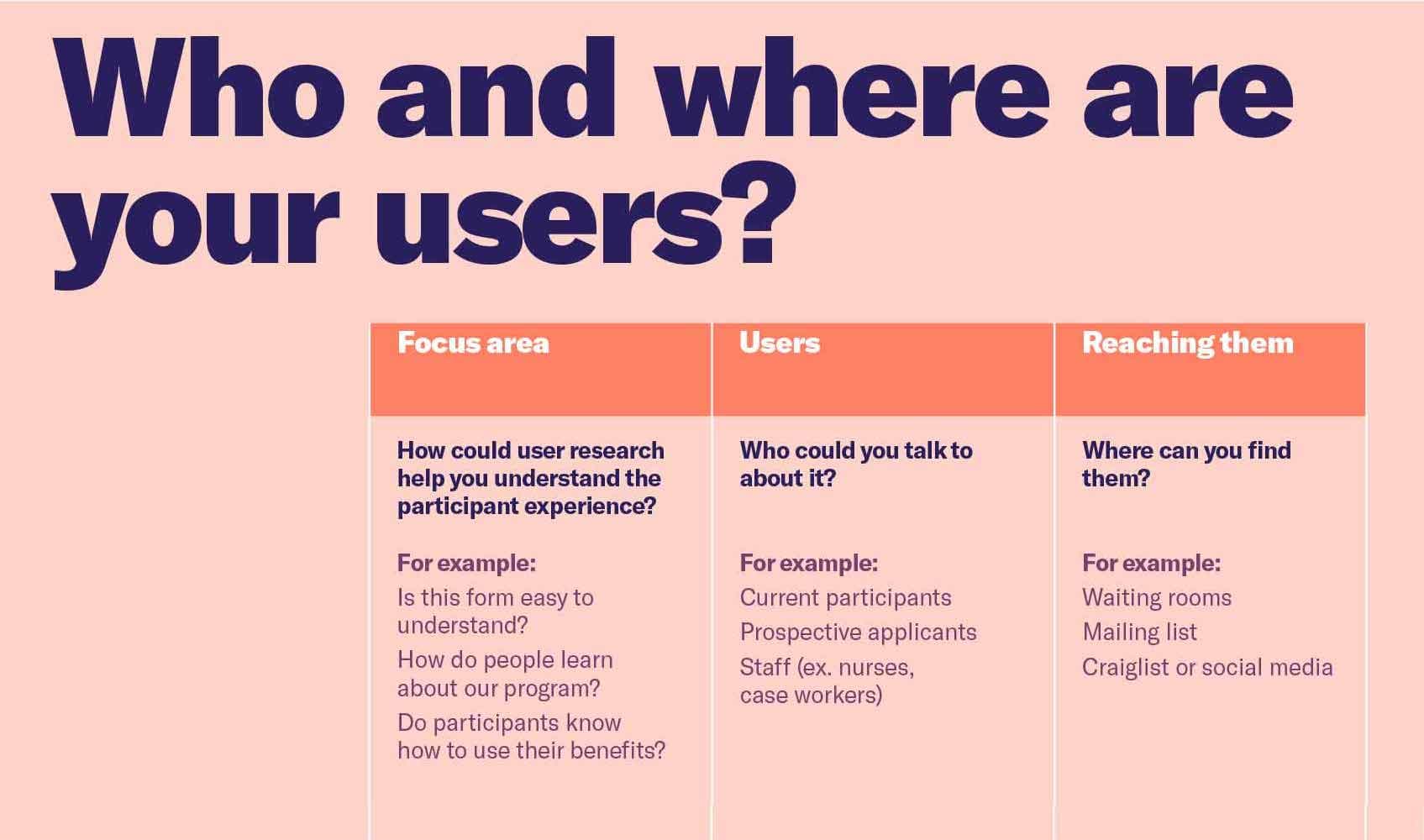These toolkits were developed with the WIC Technology Resource Group, a resource and learning partnership between the National WIC Association and Nava, with contributions from Code for America. Many thanks to Mandy Brown and Sasha Reid for their invaluable contributions.
Technology can be used to achieve meaningful program outcomes when you focus on what people need, approach projects one manageable part at a time, and measure outcomes.
This toolkit is the third of four that will walk you through human-centered and agile processes to help you achieve meaningful program outcomes with every new technology project. We recommend using them in this order: Setting goals, Building technology, Engaging users, and Measuring success.
This toolkit can help you:
- Center technology development around what people really need
- Iterate on and improve your technology product based on feedback from real users
Human-centered design is:
a methodology for designing and building unified, clear, and respectful products and services that incorporates feedback from the people you are designing for throughout the design process. Its core principles are to build an explicit understanding of users, involve them throughout the development process, test and iterate frequently, and address the whole user experience of a product or service.
Agile development is:
a collection of project management and software development practices that shorten feedback loops and rely on constant feedback, iteration, and collaboration to improve products and help teams quickly, safely, and cost-effectively build software that meets people’s needs.
Once you have an understanding of your goals and how to build the technology, you’re ready to start engaging users. As you learn from users, you can apply their feedback to iterate and improve on your project. Talking to people early and often will help ensure you build the right thing to solve the right problem.
Building with, not for, users
Building technology based on assumptions about what people need is risky. Engaging users throughout the process gives you valuable insight and feedback along the way, and increases the likelihood that you’ll build something that truly meets user needs.
User describes anyone who will use your technology product. This general term helps you think about people in relation to the product you’re building. However, once you’ve identified who your users are, you should use more specific words to describe them, i.e. participants, WIC frontline staff, etc.
User engagement is most helpful when it happens throughout the planning, development, and implementation of technology. Engage users:
Before you build any technology to understand the problem, so that you can build something that solves the problem.
During the build to get feedback on imperfect prototypes before polishing them for implementation.
During implementation to refine what you built once it's implemented in a real-life setting.
If you don’t engage users, you could end up solving the wrong problem, building the wrong thing to solve the right problem, or building the right thing in the wrong way, so that the thing you build might not meet its full potential for solving the right problem. Engage users to get your technology product right.
How to engage users
There are many different ways to engage users — from quick, informal methods to more rigorous research. Here are three of the more accessible methods you can use when you need to learn from users, but you don’t have the formal resources to do so — like a fully staffed design or research team. They are: user interviews, observational research, and usability testing.
User interviews
Conducting user interviews is helpful when you want to:
Understand what people’s pain points and motivations are
Explore a new idea
Here’s a brief logistical overview of how user interviews work:
Conduct structured conversations with users about their experience, goals, and motivations for using a service or tool.
Talk to 6-8 potential users.
Assign one interviewer and one notetaker for each interviewee.
Find people through flyers in waiting rooms, email, or Craigslist.
Learn more about conducting interviews in Nava’s User Research Guide for Improving Forms toolkit. Use these templates to get informed consent and protect research participants’ privacy.
Observational research
Conducting observational research is helpful when you want to:
See people experiencing services or tools in real situations
Learn what actual human behavior can explain a change in data
Logistically, observational research is pretty straightforward. Just go to the place where people use the service and observe. Take notes but not companions. It’s best if there’s just one observer.
Usability testing
Conducting usability testing is helpful when you want to:
See how people will interact with a new service, technology, tool, or process change
Evaluate a new idea
Here’s a brief logistical overview of how useability testing works:
Get 3-5 people to complete a task on a prototype
Ask them to think aloud and watch where they make mistakes or seem confused
Assign one interviewer and one notetaker for each interviewee
Find people through flyers in waiting rooms, email, Craigslist
Even small, lightweight approaches to user research can make a big impact on the technology project you’re building. User interviews, observational research, and usability testing can be conducted throughout your project: from planning to building to implementing.
Try it: See how user research fits into your work
How could user research help you understand the participant or staff experience? Who could you talk to about it? Where can you find them?
What user research methods do you want to try in your human-centered technology project? Why?
Find examples below to help shape your thinking.

As you begin the research process, think about what you want to learn from your users, who you need to talk to, and where you can find them.
Starting small and iterating
Building everything in a technology project all at once is expensive and messy — and you lose the opportunity to engage users. If you start small instead, you can quickly, cheaply, and safely test your idea with real people to see what’s working and what’s not. Iterating is about embracing feedback and learning at every stage of the process.
Building modularly
Starting small can mean starting with one module. Reasons for this this include:
Makes a large multi-module project more approachable
Lowers risk of failure and wasting resources
Opportunity to learn and iterate, and apply that experience in the development and implementation of other modules
Potential for high impact, even with just one small project
Learn more about using a modular approach to development in Building technology.
Using prototypes for learning
Another way to start small is to create and test a prototype. A prototype is a tool for learning, basically a lightweight representation of something you want to build.
Prototypes can help you:
Test your understanding of user needs
Uncover unintended consequences
Identify the limits of known constraints
Gauge if your intervention is helpful
One of the best things about prototypes is that they can help you learn all these things without being a super polished, perfectly designed product. A prototype can be anything, and anyone can make one — it’s simply a representation of something you want to make. It can be a drawing on a piece of paper. And testing that prototype can even be as informal and fast as printing something out in the office, walking it over to the lobby, and asking a few participants if they have a quick minute to take a look at it.
Try it: Start small
Think about a participant or staff challenge that you’re interested in solving with technology. What’s the smallest possible thing you could build first? What’s the cheapest, fastest way possible to test out a potential solution?
The important thing about starting small and iterating is that you can learn what works and what doesn’t so you don’t end up spending time and resources building something that doesn’t meet user needs. Learn more about starting small in Building technology.
Once you have a plan for building your technology, you’re reading to start thinking about Measuring success.
About the WIC Technology Resource Group
The WIC Technology Resource Group is a resource and learning partnership between the National WIC Association and Nava, a government technology consultancy and public benefit corporation, and with contributions from Code for America, a nonprofit focused on digital tools for government.
Power your mission with human-centered, agile technology is a series of four toolkits that will walk you through human-centered and agile processes to help you achieve meaningful program outcomes with every new technology project. It includes: Setting goals, Building technology, Engaging users, and Measuring success.
For more resources, visit the WIC Hub.
Written by

Director of partnerships and advocacy

Associate Program Director of Insight & Impact, Code for America

Director of Design
